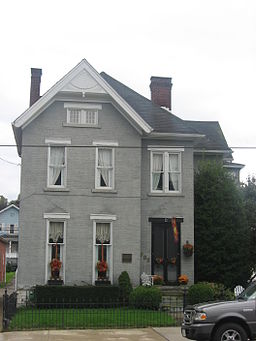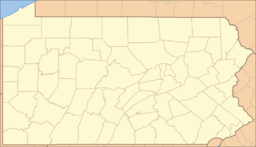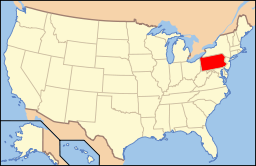- Monongahela, Pennsylvania
-
Monongahela City Edward G. Acheson House in 2011Official name: City of Monongahela Named for: Monongahela River Nickname: Mon City Country United States State Pennsylvania County Washington Coordinates 40°12′2″N 79°55′42″W / 40.20056°N 79.92833°W Area 2.1 sq mi (5 km2) - land 1.9 sq mi (5 km2) - water 0.2 sq mi (1 km2) Population 4,761 (2000) Density 2,472.4 / sq mi (955 / km2) Established 1770 Mayor Bob Kepics (D) Timezone EST (UTC-4) - summer (DST) EDT (UTC-5) Zip code 15063 Area code 724 Website: www.cityofmonongahela-pa.gov Monongahela, colloquially called "Mon City," is a Third Class City in Washington County, Pennsylvania, United States (Zip Code 15063) and is part of the Pittsburgh Metro Area, located approximately 17 miles (27 km) south of the city proper. The population was 4,761 at the 2000 census. In 1940, the population of Monongahela was 9,823, in 1950, 10,387, in 1960, 12,948, in 1970, 11,726, in 1980, 8,590, and in 1990.
One of only two cities in Washington County, and the second smallest city in Pennsylvania (after Parker, Pennsylvania), Monongahela sits at the intersection of Pennsylvania state routes 136, 88, and 837, all of which constitute the city's Main Street.
Contents
Geography & climate
Monongahela is located at 40°12′2″N 79°55′42″W / 40.20056°N 79.92833°W (40.200462, -79.928394)[1].
According to the United States Census Bureau, the city has a total area of 2.1 square miles (5.4 km2), of which, 1.9 square miles (4.9 km2) of it is land and 0.2 square miles (0.52 km2) of it (9.86%) is water.
The city receives 37.65 inches (956 mm) of rainfall annually and has a mean annual temperature of 63 °F (17 °C).
Demographics
As of the census[2] of 2000, there were 4,761 people, 2,139 households, and 1,264 families residing in the city. The population density was 2,472.4 people per square mile (952.5/km²). There were 2,382 housing units at an average density of 1,237.0 per square mile (476.5/km²). The racial makeup of the city was 94.94% White, 3.26% African American, 0.08% Native American, 0.19% Asian, 0.42% from other races, and 1.11% from two or more races. Hispanic or Latino of any race were 0.71% of the population.
There were 2,139 households out of which 23.0% had children under the age of 18 living with them, 42.0% were married couples living together, 12.8% had a female householder with no husband present, and 40.9% were non-families. 36.3% of all households were made up of individuals and 19.6% had someone living alone who was 65 years of age or older. The average household size was 2.20 and the average family size was 2.87.
In the city the population was spread out with 20.1% under the age of 18, 6.9% from 18 to 24, 27.4% from 25 to 44, 22.6% from 45 to 64, and 23.0% who were 65 years of age or older. The median age was 42 years. For every 100 females there were 85.3 males. For every 100 females age 18 and over, there were 80.6 males.
The median income for a household in the city was $29,060, and the median income for a family was $36,528. Males had a median income of $31,250 versus $23,911 for females. The per capita income for the city was $16,903. About 11.1% of families and 13.6% of the population were below the poverty line, including 25.9% of those under age 18 and 7.2% of those age 65 or over.
History
What is now the City of Monongahela was founded in 1769 on a tract of land near the confluence of Pigeon Creek and the Monongahela River. It is the oldest settlement in the Monongahela River Valley and most likely the oldest in Washington County.[3] The original tract of land was actually owned by three different men, who named their land areas Eden, Paradise, and Gloucester. Joseph Parkison, who operated a ferry on the west bank of the Monongahela River, is recognized as the founder of Monongahela. Parkison built the town’s first post office, and in 1782 the town was officially recognized as Parkison’s Ferry. Adam Wickerham took claim to 130 acres (0.53 km2) on the Parkison Ferry tract, July 1, 1788. On this tract he laid out Georgetown in 1807. Georgetown was made part of Williamsport by him on Feb. 23, 1816. In 1833 the first borough officers were elected for Williamsport. On April 1, 1837 Wiliamsport was given the name Monongahela City and in 1893 shortened to Monongahela.
The word Monongahela is Native American in origin, meaning “falling banks”. The Monongahela tribe was also indigenous to the area prior to the settlement of the city.
Places of interest
Monongahela is home to many parks, playgrounds and museums. Chess Park, located near the center of the city, hosts community events throughout the year. The Mounds Park, built on the site of an ancient Indian Burial Ground, is a local playground and sports complex. On the banks of the Monongahela River is the Aquatorium, a waterfront venue that hosts the annual Fourth of July celebration. The Historical Society Museum and Monongahela River Museum are also located within the city.
Whiskey Point, a bluff overlooking the Monongahela River located within the city, was an important meeting place during the Whiskey Rebellion. The Pennsylvania State Historical Marker located here reads: "The bluff at Main St. and Park Ave. was the site on Aug. 14, 1794, of a meeting of 226 whiskey rebels. Albert Gallatin's eloquence turned the tide, resulting in peaceful ending of the Whiskey Rebellion and the possibility of civil strife."
Many buildings in Monongahela, such as the Longwell House and the Bethel A.M.E Church, were used by freed slaves as stops on the Underground Railroad.
There are twenty churches representing fifteen denominations located in Monongahela.
Park Avenue
Park Avenue, a two mile (3 km) stretch of road in Monongahela, has fostered a remarkable amount of notable people, most famous among them NFL Hall of Fame Quarterback Joe Montana.
Other notable residents include Carl E. Vuono, four star general and Chief of Staff of the U.S. Army; Jim Jimirro, founder of the Disney Channel; Fred Cox, all-time leading scorer for the Minnesota Vikings and inventor of the Nerf ball;and Dr. Ronald V. Pellegrini, a world renowned cardiothoracic surgeon based in Pittsburgh.
A documentary about Park Avenue, titled “One Extraordinary Street” was released in 2008, produced by Laura M. Magone.[4]
Notable people
- Edward Goodrich Acheson, American chemist, inventor of Carborundum
- Mitch Daniels, Governor of Indiana and former Director of the Office of Management and Budget (2001–2003)
- John Taylor Gatto, New York State 1991 teacher of the year and education reformer
- Anthony Peterson, former NFL linebacker
- Charles D. Provan, Christian theologian and author
- Scott Zolak, former NFL quarterback
See also
References
- ^ "US Gazetteer files: 2010, 2000, and 1990". United States Census Bureau. 2011-02-12. http://www.census.gov/geo/www/gazetteer/gazette.html. Retrieved 2011-04-23.
- ^ "American FactFinder". United States Census Bureau. http://factfinder.census.gov. Retrieved 2008-01-31.
- ^ http://history.rays-place.com/pa/wash-monongahela.htm
- ^ http://www.post-gazette.com/pg/08328/929534-58.stm
External links
Municipalities and communities of Washington County, Pennsylvania Cities Monongahela | Washington
Boroughs Allenport | Beallsville | Bentleyville | Burgettstown | California | Canonsburg | Centerville | Charleroi | Claysville | Coal Center | Cokeburg | Deemston | Donora | Dunlevy | East Washington | Elco | Ellsworth | Finleyville | Green Hills | Houston | Long Branch | Marianna | McDonald‡ | Midway | New Eagle | North Charleroi | Roscoe | Speers | Stockdale | Twilight | West Brownsville | West Middletown
Townships Amwell | Blaine | Buffalo | Canton | Carroll | Cecil | Chartiers | Cross Creek | Donegal | East Bethlehem | East Finley | Fallowfield | Hanover | Hopewell | Independence | Jefferson | Morris | Mount Pleasant | North Bethlehem | North Franklin | North Strabane | Nottingham | Peters | Robinson | Smith | Somerset | South Franklin | South Strabane | Union | West Bethlehem | West Finley | West Pike Run
CDPs Unincorporated
communitiesAmity | Avella | Blainsburg | Bulger | Condit Crossing | Eighty Four | Fallowfield | Glyde | Laboratory | Langeloth | North Fredericktown | Paris | Prosperity | Raccoon | Richeyville | Scenery Hill | Studa | Taylorstown | West Alexander
Footnotes ‡This populated place also has portions in an adjacent county or counties
Categories:- Cities in Pennsylvania
- Populated places in Washington County, Pennsylvania
- Populated places established in 1769
- Pittsburgh metropolitan area
Wikimedia Foundation. 2010.




